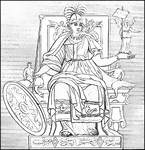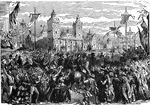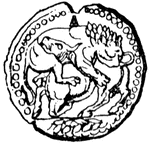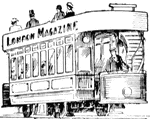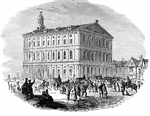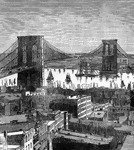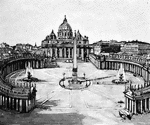
The Draft Riots in New York - The Battle in Second Avenue
Rioting in New York City after passage of an unpopular draft.

The Sixth regiment
Thousands of patriotic citizens filled every available space in the big railroad station in Jersey City…

Landing of Captain Bailey and Lieutenant Perkins in New Orleans
Captain Bailey, bearing a flag of truce, put off in a boat, accompanied by Lieutenant George H. Perkins,…

Drilling Troops
The influx of Northern regiments of troops into Washington during the early days of the war rendered…

Paul Ansel Chadbourne
Portrait of Paul Ansel Chadbourne, an American educator. Born in New Berwick, ME., Oct. 21, 1823. Died…
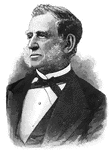
William Earl Dodge
Born in Hatford, Conn., Sept. 4, 1805; died in New York City, Feb. 9, 1883. First director of the Erie…
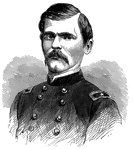
General George C. Strong
At the assault on Fort Wagner, July 18, he was mortally wounded. He was at once removed to New York…

Fort Pulaski
Fort Pulaski, on Cockspur Island at the entrance to the Savannah River, Georgia, was built by the United…
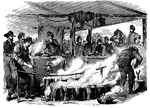
Cooking in Camp
The kitchen of the Fremont Dragoons at Tipton, Missouri. Tipton, which is 38 miles from Jefferson City,…

Camp Lillie
Headquarters of General Freemont, Jefferson City, Missouri, October 1, 1861. Jefferson City is on the…

Petit Palais
The Petit Palais (Small Palace) is a museum in Paris, France. It was built for the Universal Exhibition…
Rappahannock
"The city of Fredericksburg, VA., from the North side of the Rappahannock- from a sketch by our special…
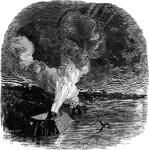
Siege of Island
"Siege of Island No. 10, on the Mississippi River- night bombardment by the Federal mortar boats, ten…

Great Bakery
"The Great Bakery for the United States Army at the Capitol, Washington, D. C.- sketched by our special…

Bombardment of Island No. 10
"Bombardment of Island No. 10 and the fortifications opposite, on the Kentucky Shore, by the Federal…
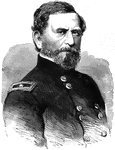
J. T. Sprague
"General J. T. Sprague, born in Newburyport, Mass., July 3rd, 1810, died in New York city, September…

Officer's Tents
"New Jersey Camp at Arling, Va., designated as Camp Princeton in honor of one of the Revolutionary battle…

Theodore Runyon
"New Jersey Camp at Arling, Va., designated as Camp Princeton in honor of one of the Revolutionary battle…
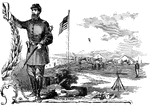
Aid-de-camp
"New Jersey Camp at Arling, Va., designated as Camp Princeton in honor of one of the Revolutionary battle…

Camp Princeton
"New Jersey Camp at Arling, Va., designated as Camp Princeton in honor of one of the Revolutionary battle…
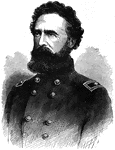
George Sykes
"General George Sykes, born in Dover, Del., October 9th, 1822, died in Brownsville, Texas, February…

Military authorities
"The military authorities at Washington, D. C., examining passes in 1861. This scene was of frequent…

Battle of Charles City
"Battle of Charles City Road- charge of the Jersey Brigade- the first New Jersey brigade, General Tayler,…

Zouaves
"Encampment of Colonel Ellsworth's New York Fire Zuoaves, on the heights opposite the Navy Yard, Washington,…

Bouquet Battery
"The Bouquet Battery, commanding the viaduct over the Patapsco River, on the Baltimore and Ohio Railroad,…
Occupation of Norfolk
"Occupation of Norfolk, VA., by the Federal troops- view of the city- Federal vessels at anchor." —Leslie,…
Federal Fleet
"Panoramic view of the Federal fleet passing the forts of the Mississippi, on its way to New Orleans,…

Rappahannock Bridge
"Rebuilding of the railroad bridge over the Rappahannock to Fredericksburg, burnt by the Confederates…
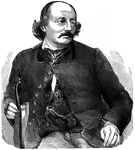
General Benjamin F. Butler
"General Butler was born in Deerfield, N. H., November 6th, 1818. At the time of President Lincoln's…

Blue Ridge Pass
"The victory at Blue Ridge Pass, Sunday, September 14th, 1862- infantry charge, and rout of the Confederates.…

Police Headquarters
"Interior of the outbuilding attached to Marshal Kane's Police Headquarters, Holliday Street, Baltimore-…

Bellaire, Ohio
"Bellaire, O.- Steamboats conveying troops and munitions of war for the Federal forces on the Great…
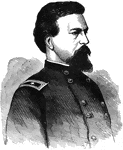
General Alexander S. Webb
"General Webb, born in New York city, February 15th, 1835, was graduated from the United States Military…

New Fernandina
"Federal troops marching through Second Street, New Fernandina, Fla. Our sketch of New Fernandina in…

Frederick City
"General McClellan and the Federal troops passing through Frederick City, Md., in pursuit of the Confederate…

Rolla Camp
"Encampment of the Federal army near Rolla, Mo. The city of Rolla has been famous since the death of…
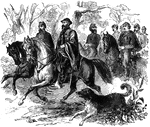
Battle of Pea Ridge
"General Asboth and staff at the Battle of Pea Ridge, Ark., March 6th-8th, 1862. The gallantry displayed…

Jefferson City, Missouri
"Jefferson City, capital of Missouri. The arrival of General Fremont's division, September 26th, 1861.…

Red Snapper
"The Florida or Pensacola red snapper is it is commercially known, because that city is headquarters…

Army of the Potomac
"Advance of the Army of the Potomac. Occupation of Winchester, VA., and the abandoned Confederate Fortifications,…

Columbus, Kentucky
"General view of Columbus, Ky., and its fortications, looking down the river, showing the 'Iron Bluffs'…

Paducah, Kentucky
"View of the town of Paducah, Ky., at the confluence of the rivers Ohio and Tennessee, the Northern…

Confederate Fortifications
"Interior of the principal Confederate fortifications near New Berne, N. C., after their capture by…

Federals Crossing
"Federal Volunteers crossing from Cincinnati to Covington on a bridge of coal boats, constructed for…

General George H. Sharpe
"General Sharpe, born in Kingston, N. Y., February 26th, 1828, was graduated at Rutgers in 1847; studied…
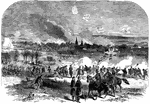
Bombardment of Fredericksburg
"Bombardment of Fredericksburg, Va., by the army of the Potomac, commanded by General Burnside, Thursday,…

